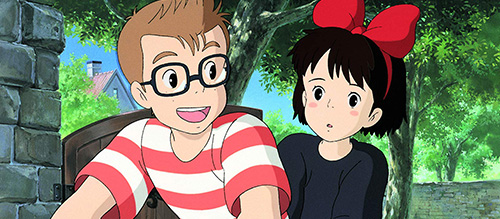Kiki’s Delivery Service (1989) Review
Kiki’s Delivery Service (1989)
Director: Hayao Miyazaki
Screenwriter: Hayao Miyazaki
Starring: Minami Takayama, Rei Sakuma, Kappei Yamaguchi, Keiko Toda, Minami Takayama, Mieko Nobusawa
Kiki’s Delivery Service is a lovely big hug in movie form.
Studio Ghibli maestro Hayao Miyazaki seems to have two primary storytelling modes: wondrous adventures to ponder and make you think (Princess Mononoke, Laputa: Castle in the Sky) and wondrous adventures to comfort and make you feel (My Neighbour Totoro, Ponyo) – Kiki certainly belongs in the latter category.
A near plotless coming-of-age fantasy, Kiki follows the titular young trainee witch (Minami Takayama) doing odd jobs and delivering packages for a coastal town over the course of her first year of living and working independently. Up until the final fifteen minutes or so, the most eventful thing to occur is that Kiki catches a bad head cold from flying her broom in a storm.
Hayao Miyazaki is fascinated by European cultures. Most of his films are based on European literature, from “The Borrowers” to “The Little Mermaid”, with a lot of inspiration coming from “Alice in Wonderland” – his worlds are more often than not influenced by places he’s been and customs he has seen. The look of Kiki’s pristine coastal town here is loosely based on Stockholm (though the source material by Eiko Kadono is actually Japanese) and the Scandinavian-influenced architecture and glittering azure waves are made to look very attractive indeed.
This is very similar to the late, great fantasy author Terry Pratchett’s idea of what a witch is – these aren’t evil old crones that spell doom, but hard-working, practical and versatile young women who are invaluable members of their communities. Kiki’s mother (Mieko Nobusawa) underwent her witch training many years ago and is shown to be a practiced (if clumsy) brewer of potions and medicine. Kiki also encounters a more assured (read: smug) and practiced witch en route to her new adopted home.
Kiki is not the only Studio Ghibli film that prominently features witches, though they’re usually far less appealing characters. Spirited Away has the large-headed Yubaba (basically a comic brothel matron) and Howl’s Moving Castle has the Witch of the Wastes, who regresses from obese arch-manipulator to harmless senility after an encounter with a much more powerful magic user. In Ghibli successor Studio Ponoc’s first film Mary and the Witch’s Flower, we follow another young and hopeful witch, but she is far more impulsive and headstrong than Kiki.
Miyazaki frequently incorporates magic into his stories and uses it as a shortcut to wondrous spectacle, but he is also cautious against presenting the irresponsible use of such power. In Kiki’s Delivery Service, the titular Kiki makes mistakes, she lets others down, but this only gives her a stronger drive to prove herself by helping to make other lives better.
It’s a film about self-belief, and how your drive and passion can dissipate after a few knocks to your confidence or the feeling of pure exhaustion. Everyone would like to work in a job that they are good at, that they enjoy and where they know exactly what they’re doing, but often one or more of these are lacking.
Being a witch (and a teenager seen through a Japanese cultural prism), Kiki puts up with a lot with little complaint, because it’s what is expected of her. She practically has to be forced by her few friends to take any time for herself at all, whether it’s just hanging out with kids of her own age like Tombo (Kappei Yamaguchi) or spending a few days relaxing in the country with the artistic Ursula (Minami Takayama) when she hits an insurmountable wall.
It might not be as deep or complex as top-tier Miyazaki, but Kiki does do the job. It’s beautiful to look at, it’s a hugely relatable coming-of-age film and it works really well as emotional therapy too. The morals and the presentation of Kiki clearly made an impact because it was the first Studio Ghibli film to be picked up and re-voiced by Disney for American release in 1997 (Kirsten Dunst voiced Kiki), a lucrative trend which continued for over a decade and helped introduce many fans in the West to “The Japanese Disney”.
20/24


